Best Ergomatic Cabbed-Lorry Model? PART 19.Page 28.TRUCKNETUK
VALKYRIE Quote from Best Ergomatic Cabbed-Lorry Model? PART 16.Page 22.TRUCKNETUK:-
"All being well,I will acquire some information on the Leyland 700-Series -500-Series Diesel Engines in the next few days,that hopefully will make things much more clear  "
"
Besides the above engines,I’ve also some detailed information on the AEC,ALBION,LEYLAND GKN SANKEY Ergomatic Cab.I’m not going to go in to every detail,but I will hopefully try to detail the handful of major points 
AEC,ALBION,LEYLAND GKN SANKEY ERGOMATIC CAB:THE GOOD POINTS.
The Ergomatic Cab was introduced in 1964,and was a big step forward in lorry cab design in the United Kingdom and was generally regarded as being the best cab in the UK and export markets,but I would say that at least some cabs of American,European and Scandinavian lorry and heavy motor truck models were just as good in at least most respects  But the Ergomatic was certainly a marked improvement over the Park Royal cabs for AECs and LAD cabs for Albions,Leylands and Dodges
But the Ergomatic was certainly a marked improvement over the Park Royal cabs for AECs and LAD cabs for Albions,Leylands and Dodges 
The ergonomic word was new to most people,most if not all of whom,must a have thought that Ergomatic was a strange and odd name to use for a lorry cab,and indeed almost anything else! 
 Until that is they discovered that “ergonomic” means the scientific study and application of the human being’s relationship to his/her working environments,and how best to improve these working conditions for the benefit of human beings
Until that is they discovered that “ergonomic” means the scientific study and application of the human being’s relationship to his/her working environments,and how best to improve these working conditions for the benefit of human beings 
So the use of ergonomics - possibly for the first time in overall cab design?  - showed the advanced thinking of Leyland engineers
- showed the advanced thinking of Leyland engineers  And,as I’ve stated before on this thread,most if not all the lorry drivers who drove Ergomatic-cabbed AECs,Albions and Leylands were quite pleased with this cab
And,as I’ve stated before on this thread,most if not all the lorry drivers who drove Ergomatic-cabbed AECs,Albions and Leylands were quite pleased with this cab  - it meant that it was goodbye to cold,draughty and noisey cabs!
- it meant that it was goodbye to cold,draughty and noisey cabs!  amongst other things - and many TRUCKNETUK members on this thread have confirmed that the Ergomatic cab was a good cab!
amongst other things - and many TRUCKNETUK members on this thread have confirmed that the Ergomatic cab was a good cab! 

It was a well-appointed cab,and it must have been like entering heaven for a great many lorry drivers,after years of putting up with cold,draughty and noisey cabs!  :Besides being draught-proof ,the Ergomatic cab had an 8 kilowatt heater,which worked in conjunction with Adjustable Selectavent that allowed the driver to direct hot air or fresh air to differant areas of the cab.
:Besides being draught-proof ,the Ergomatic cab had an 8 kilowatt heater,which worked in conjunction with Adjustable Selectavent that allowed the driver to direct hot air or fresh air to differant areas of the cab.
The cab was rigidly designed,it’s lower part was of double section to increase the strength,and
was mounted on a heavy gauge steel subframe to absorb mounting stresses.The cab was also well-
equipped with sound insulation material - you could easly listen to the optional radio 
Another piece of advanced thinking was the high roof version of the Ergomatic sleeper cab(1968),which pre-emptied the Volvo Globetrotter High Roof Cab (1980) by 12 years!  ,and was offered for mainly European and other export markets
,and was offered for mainly European and other export markets  :-
:-
AEC MANDATOR V8 VTG4R4263 ERGOMATIC HIGH ROOF SLEEPER-CABBED 4x2 BOXVAN ARTIC,RKR 284G,registered Friday,3rd January,1969 in Kent.Anglo Continental Transport:-
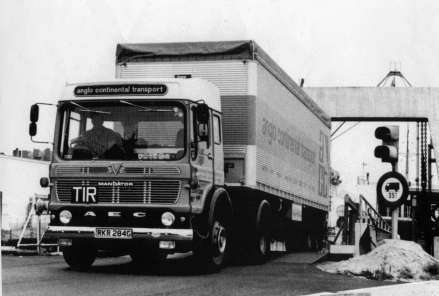
And it’s interesting to think that the Leyland Motor Corporation almost on it’s own made the “ergonomic” word an household word  ,and is now used by several other lorry manufacturers such as
,and is now used by several other lorry manufacturers such as
MAN:-
TGM TGL cabs | United Kingdom
mantruckandbus.co.uk/en/truc … _cabs.html?
After all, only a driver in top form can also produce top performances at the … LX cab. High-roof cab for long-haul transport. Comfortable access, equipped to a high … The interior is made even more ergonomic by the user-friendly dashboard …
IVECO:-
new trakker - Hi-Comfort and Ergonomics - Iveco
IVECO | Choose your market | Iveco?
The cab of the New Trakker is designed around the driver. Class-leading … Hi-Comfort and Ergonomics · Hi-Land … o long with high roof (Hi-Track) The driver’s …
MERCEDES-BENZ:-
which is ergonomic, functional and stylish has been designed with high …
[PDF]
The Atego. The Axor - Mercedes-Benz UK
tools.mercedes-benz.co.uk/current/trucks/.../atego-axor-distribution.pdf?
The comfort air-sprung suspension seat with its ergonomic design and … Ergonomic
ISUZU:-
ISUZU:Ready & Reliable ISUZU F-Series
isuzu.co.jp/world/product/f_ … mfort.html?
Pure pleasure - it’s the only way to describe the comfort of the F-Series cab. … the cab features ergonomic seating and a wide variety of storage solutions. … For the ultimate in comfort, an air-suspension seat, high-roof cab, spacious bunk and …
So all the above,including the MAN,ISUZU,IVECO and MERCEDES-BENZ quotes,shows you what an advanced,influential and pace-setting design the Ergomatic Cab was in 1964! 

AEC,ALBION,LEYLAND GKN SANKEY ERGOMATIC CAB:THE BAD POINTS.
The design and groundbreaking ideals of the Ergomatic Cab were largely sound,and became reality in the AEC,Albion and Leyland production versions of this cab  But,alas!
But,alas!  It did have problems,some of which were never fully resolved during it’s production life
It did have problems,some of which were never fully resolved during it’s production life 

1.The Ergomatic Cab was designed and promoted as a tilt cab,but some lightweight lorry models
were fitted with none-tilting fixed Ergomatic cabs  ,access to the engine was obtained in the old-
,access to the engine was obtained in the old-
fashioned way:Getting in to the cab and lifting the bonnet! 

2.Because of the low cab floor,which was lower than in the LAD Cab for example,the engine cover-bonnet took up more space in the cab than previously,and because the service points were mounted
on top and on the left hand side of the engine,the bonnet-cover was offset from the centre towards the lefthand side.This caused the passenger area to be cramped,and on lefthand drive versions  - which is where the driver was positioned of course
- which is where the driver was positioned of course  - the cramped conditions were even worse because of all of the driving controls
- the cramped conditions were even worse because of all of the driving controls  In this LHD version the engine was inclined to the right to make more room for the driver and handbake and gearlever controls - in the RHD version the engine was inclined towards the left to allow more room for the said controls.
In this LHD version the engine was inclined to the right to make more room for the driver and handbake and gearlever controls - in the RHD version the engine was inclined towards the left to allow more room for the said controls.
To allow as much room in the cab as possible,the bonnet-engine cover panels were positioned really close to the engine,which restricted the air flow over the engine,which in turn produced engine cooling problems especially in the tropical climates of certain export countries 
3.The above cooling problems were further compounded by the fact that the engine bay and engine-bonnet- engine cover panels were just not big enough for the largest engines,namely the AEC AV690,AV691 and AV760,and Leyland O.600,0.680 and 0.690,because the cab designers unbelievably failed to take in to account these engines! 

 They just used engine outline drawings for the smaller AEC and Leyland engines for setting the engine bay measurements for the production Ergomatic cabs!
They just used engine outline drawings for the smaller AEC and Leyland engines for setting the engine bay measurements for the production Ergomatic cabs! 


GKN Sankey had tooled up and it was too late to make major cab structure alterations 
According to my information,this cooling problem was never fully resolved throughout the cab’s production life  Although the later higher mounted Ergomatic Datum Cab did improve things.
Although the later higher mounted Ergomatic Datum Cab did improve things.
4.Another problem was metal corrosion of these cabs due to box section-type design for at least some parts of the cab,minimal anti-corrosion protection and outside storage in all weathers of new vehicles at the factories and/or dealers 
AEC MANDATOR V8 ERGOMATIC THROUGH-WAY CAB.
The AEC 800-Series and 801-Series V8-cylinder engines took up less space than the AEC and Leyland straight six engines that usually powered the Ergomatic-cabbed lorry models.
The size of the engine cover and bonnet were reduced to such an extent,that this gave unrestricted cross-cab access,hence the Through-Way name  But alas!
But alas!  The standard height of the cab mounting caused engine cooling problems
The standard height of the cab mounting caused engine cooling problems  ,and some of the alterations that were made to try and get
,and some of the alterations that were made to try and get
rid of these cooling problems included the fitting of the Ergomatic Datum Cab that was mounted 5 1/2 inches higher than the standard Ergomatic cab.The Mandator V8 was the only AEC lorry model that was fitted with the datum cab,although all the Leyland 500-System lorry models were so fitted.
AEC MANDATOR V8 VTG4R047 4x2 REFRIGERATED BOXVAN ARTICULATED LORRY,MEE 910F,registered on Friday,7th June,1968 in Grimsby.Humber Warehousing Group:-
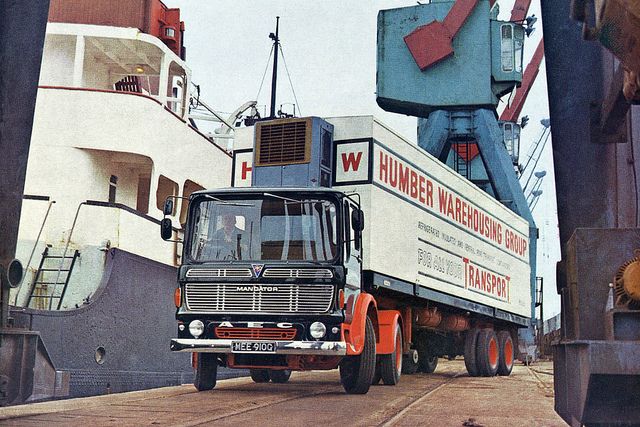
LEYLAND-AEC MARATHON ERGOMATIC-BASED HIGH TOWER CAB.
The Leyland-AEC Marathon was a stop-gap premium-specification lorry range,developed on a restricted budget,designed to compete with the Volvo F88s and Scania 111s of this world  The Leyland-AEC design team knew that the Ergomatic cab was too small for a premium long distance heavy lorry.So the team designed a new cab that employed both new parts and also incorporated certain Ergomatic cab components
The Leyland-AEC design team knew that the Ergomatic cab was too small for a premium long distance heavy lorry.So the team designed a new cab that employed both new parts and also incorporated certain Ergomatic cab components 
Because the Marathon used high power output engines,a great deal of attention was paid to vastly improving the cooling system of the engine:A major step was that the engine cover-bonnet was lowered by mounting the cab higher than on previous models.
Leyland and AEC engines seem to have been jinxed with cooling problems  ,even in the Marathon,where
,even in the Marathon,where
the cooling system had been improved:Some Marathon demonstrators were sent to Middle East countries and experienced cooling problems 
The Marathon’s high tower cab was better appointed than the standard Ergomatic cab,had increased
interior space and the modular design provided equal ergonomics for both righthand and lefthand
drive models 
AEC-LEYLAND MARATHON Mk2 2T25/27 4x2 TRACTIVE UNIT,PSG 572V,owned by John Tweedie:-
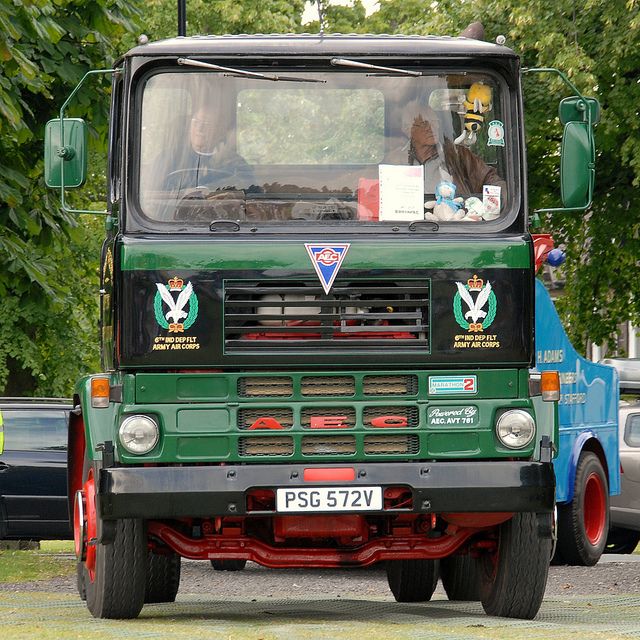
I think that I have covered,hopefully,all -or most at least - of the major aspects of the AEC,ALBION,LEYLAND GKN SANKEY ERGOMATIC CAB in this post.The Ergomatic Cab certainly set new standards - in righthand drive form at least - in cab design for British lorries,and almost certainly in certain lorry ranges made by at least some overseas commercial vehicle manufacturers  And,as I have already stated several times in this thread,many lorry drivers,many of whom are TRUCKNETUK Members,not only liked the AEC,Albion and Leyland Ergomatic-cabbed lorries,they also liked driving the Leyland-AEC Marathon lorry models too
And,as I have already stated several times in this thread,many lorry drivers,many of whom are TRUCKNETUK Members,not only liked the AEC,Albion and Leyland Ergomatic-cabbed lorries,they also liked driving the Leyland-AEC Marathon lorry models too 
THINGS TO COME.
With this newly acquired information,I will hopefully deal with the Leyland 700-Series and 500-Series Fixedhead Diesel Engines in my next post 
Meanwhile…I will reply to Newmercman’s post  :-
:-
Newmercman:
The politicians were not making decisions at BL, they were only throwing money at it, huge amounts of money that were being used as operating funds rather than investments for the future, as they were supposed to be. The reason for this was the lost revenue from strikes hurt the finances of the group so much that it needed constant bail outs just to remain in business.
Carryfast’s remedy would have been to add to the financial problems by buying in engines! This would have then set the group engine plants off, they would have gone on strike, their brothers on the assembly lines would have done their ‘one out, all out’ thing and nothing would have been built!
The history of BL is well documented, the failure of the group had SFA to do with the truck division, the Ergo cab, the 500 series engines or anything else. However, we won’t let the facts interfere in a good argument…
VALKYRIE replies:-
From 1968 to 1975 the British Leyland Motor Corporation was an independent,financially self-
supporting corporation,with no Government money supporting it at all.
It is well known that Truck and Bus Division profits were used to support the lost cause
Austin Morris Division that mass produced motorcars,which deprived British Leyland of money
to spend on developing new lorry,motorcoach,bus and engine ranges.This situation proved to be a
disaster for Leyland’s Truck and Bus Division.
Government money began supporting British Leyland when the company became state-owned in 1975.
British Leyland always bought many engines from outside engine builders,such as ■■■■■■■■■■■■■■■
Diesel,Gardner,Perkins and Rolls-Royce 
…and still meanwhile  …Bristol motorcoaches and buses are better known than Bristol
…Bristol motorcoaches and buses are better known than Bristol
lorries,but the great Bristol marque is the marque that is going to have The Last Say in this Post No.19:
Bristol is the seventh ex-British Leyland marque to have the last say,the other marques are featured in my other recent posts in this thread.This feature honours these marques  ,which is in direct contrast to what British Leyland mis-management criminally did to them!!!
,which is in direct contrast to what British Leyland mis-management criminally did to them!!! 




Well known motorcoach and bus engineer,Geoffrey Hilditch,used the “FIRM FOUNDATION - BRISTOL FASHION” title for the Bristol chapter in one of his great books,and with good reason,because the Bristol make generally became synonymous with high quality,reliability and durability 
BRISTOL MARQUE BADGES ON A BRISTOL PV2 RADIATOR FOR L AND K MODELS -GHT 127 Bristol K5G ECW O56R
Double Decker Bus,Bristol C3315:-
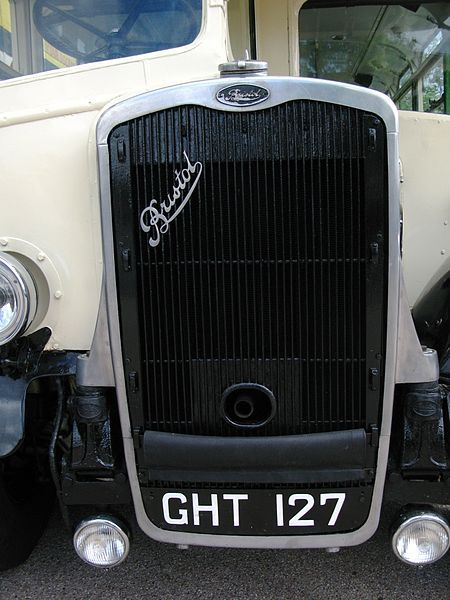
BRISTOL 4-TON TYPE,DROPSIDE-BODIED,4x2 LORRY,CHASSIS No.1270,BUILT IN 1920,USED AS BRISTOL TRAINING VEHICLE,REGISTERED IN 1935 AS BAE 592,SOLD TO C.HAWKINS AND SON AS A FURNITURE VAN:-
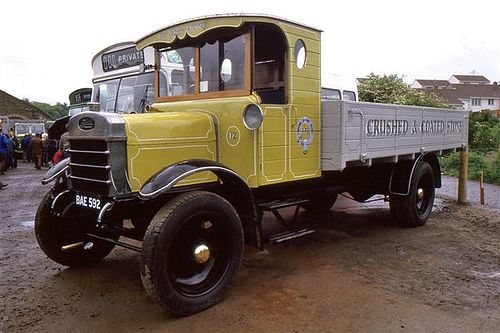
BRISTOL.TOURS FROM BATH BY BRISTOL MOTOR COACHES,Bristol Tramways and Carriage Co.Ltd,advertisement:-
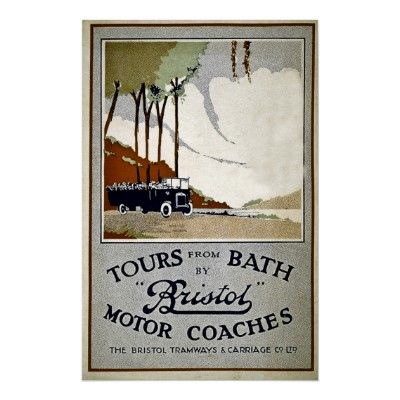
BRISTOL L5G/EAST LANCS 4x2 TOWER LORRY,CET 440,1940,EX-ROTHERHAM 157,AS A B32C SD BUS.Converted in to a Tower Lorry for the trolleybus system.Preserved:-
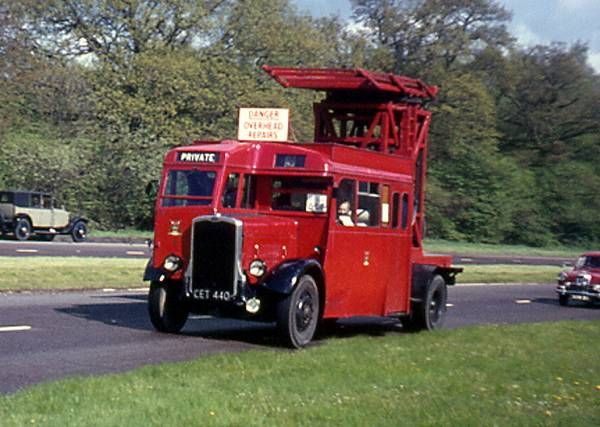
BRISTOL L6G/DUPLE C31F MOTORCOACH,DDF 44,1939.BLACK AND WHITE MOTORWAYS 100:-
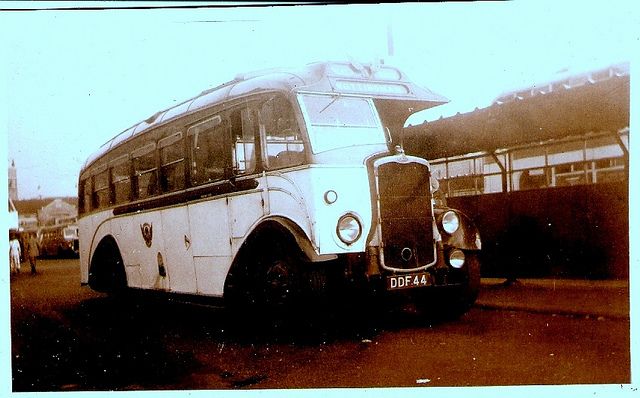
BRISTOL HA6LL,LONGWELL GREEN FGC/2-CABBED,4x2 FLAT-BODIED ARTICULATED LORRY,CHASSIS No.182045,339 DOA,1961.BRITISH ROAD SERVICES 1E1045:-
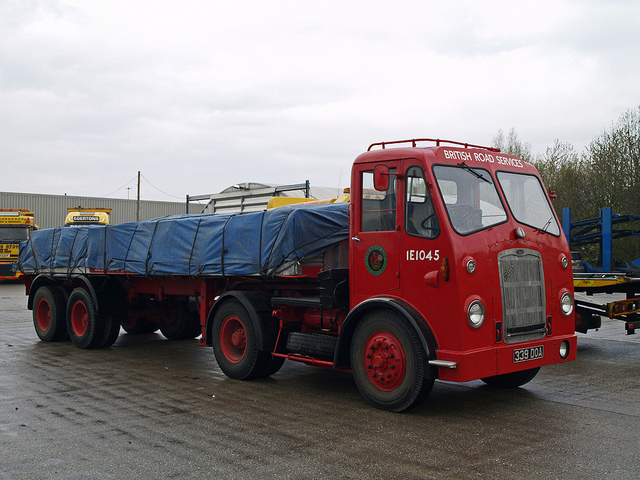
No survey of Bristol Commercial Vehicles would be complete without a Bristol Fairground Bus! 
 ,or Fairground Motorcoach!
,or Fairground Motorcoach! 
 - these were very popular fairground vehicles
- these were very popular fairground vehicles  :-
:-
BRISTOL JO5G/ROE B32F BUS/WILKES AND MEADE C33F MOTORCOACH,DT 9084,1937.DONCASTER 10,then Kildare Motorcoaches who had it converted as a motorcoach -a fairground vehicle later on:-
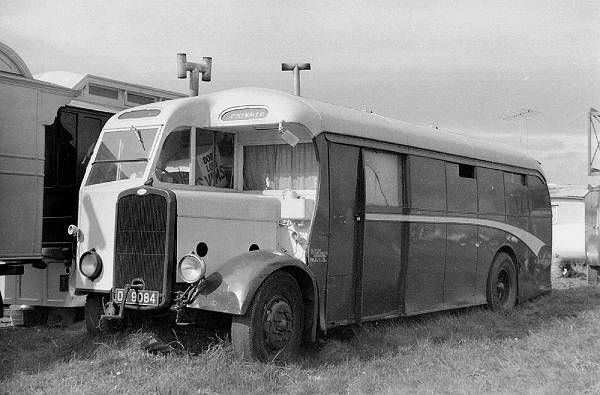
BRISTOL VRT/SL-2/320-2/EAST LANCS H73F DOUBLE DECKER BUS,OWE 271K,August,1972.SHEFFIELD No.271.
Preserved:-
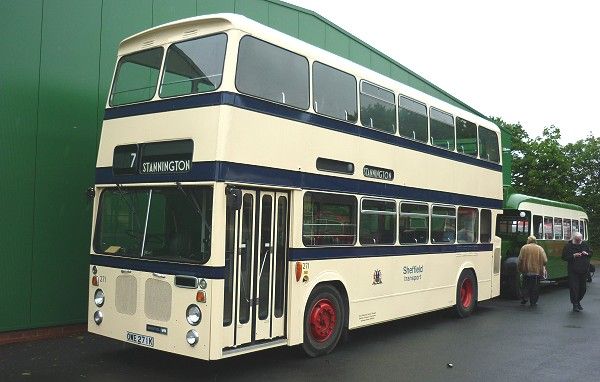
BRISTOL HG6L,HOLMES-CABBED,BRISTOL FLAT-BODIED,8x2 LORRY,CHASSIS No.88197,RGC 251,JUNE 1955.BRITISH ROAD SERVICES 61A444:-

BRISTOL.The last motor vehicle to be built by Bristol - Leyland Olympian ONLXB/1R/ECW Double Decker Bus,Chassis No.ON995,A686 KDV,September 1983.Devon General No. 1814.Preserved:-

VALKYRIE.
![]()
![]()
![]()












